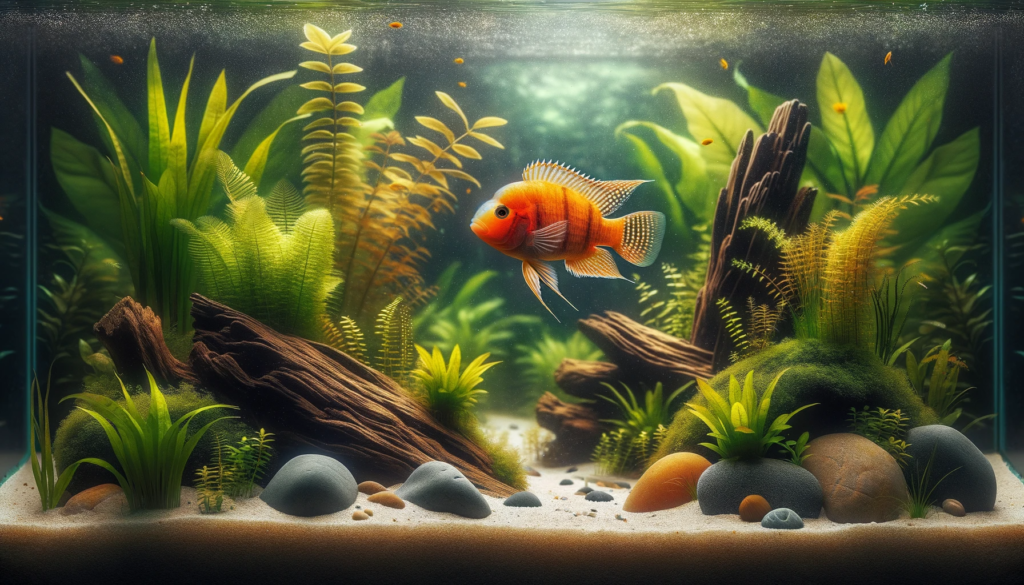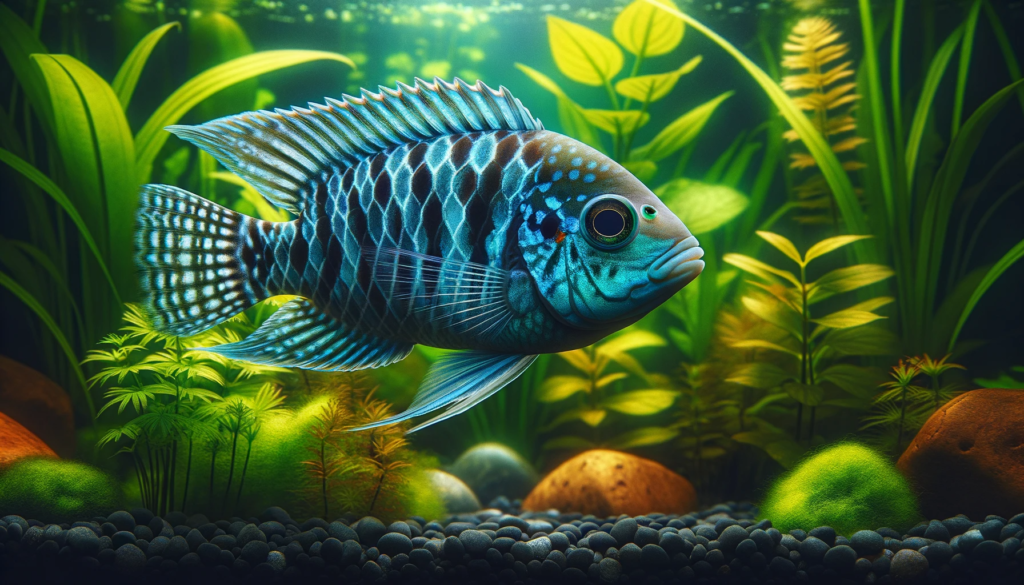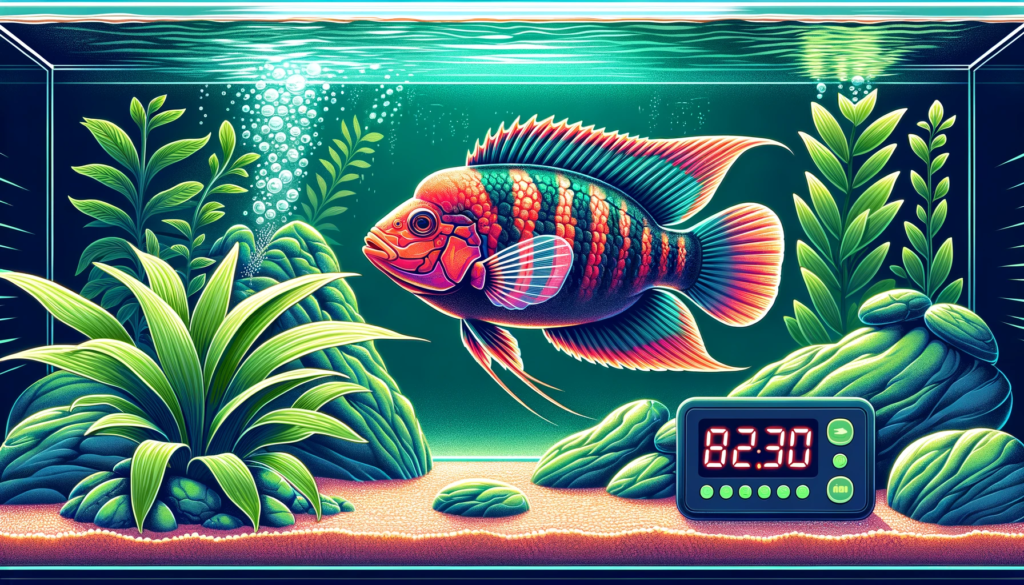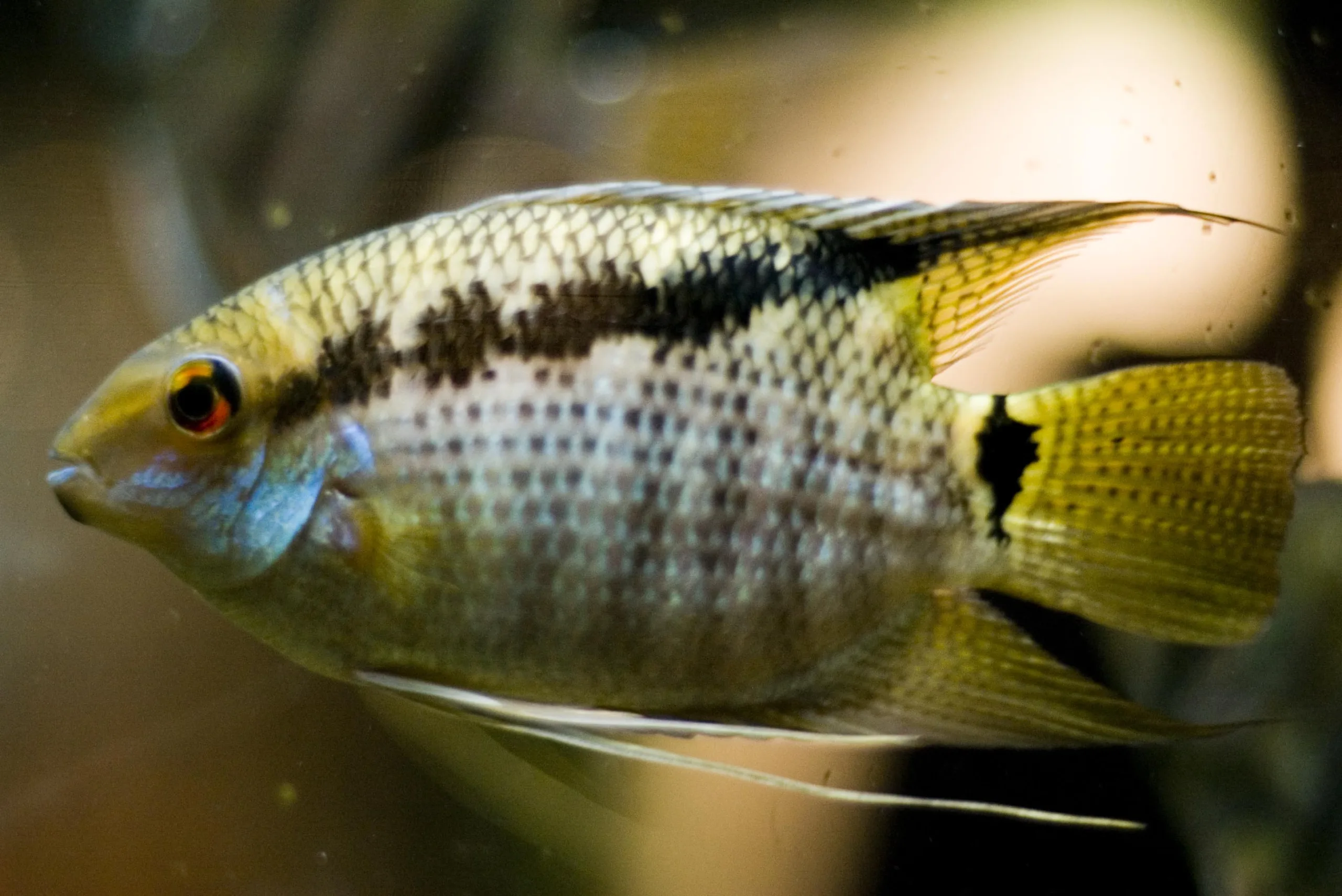Flag Cichlids are beautiful fish that can make a great addition to any freshwater aquarium. Cichlids are known for their unique behaviors and vibrant colors, making them a popular choice for both beginner and experienced aquarists.

This guide will provide an overview of what to expect when caring for a Flag Cichlid, including information on appearance & behavior, tank requirements, diet, and breeding.
With the right care, Flag Cichlids can be a fun and rewarding addition to your aquarium.
Overview and Quick facts

The Flag Cichlid is a fascinating fish species that is relatively easy to care for. Native to the rivers of Central and South America, these cichlids are popular aquarium fish for both their vivid colors and active personalities. When properly cared for, Flag Cichlids can live for up to 15 years. To ensure a healthy and happy Flag Cichlid, it’s important to make sure they have plenty of exercise and the correct water temperature.
Here are some quick facts about the Flag Cichlid:
- Scientific name: Mesonauta festivus
- Native to: Paraguay, Bolivia, Brazil, and Peru
- Size: Can grow up to 15 cm (4.8 inches) long14
- Shape: The body of the Flag Cichlid is an angular oval shape and is strongly compressed laterally with pointed anal and dorsal fins2
- Behavior: Peaceful and can be kept with other peaceful fish1
- Level: Suitable for all levels of fish keeping, from beginner to intermediate1
- Reproduction: Oviparous species that form pairs in groups5
Fun fact: Until 1991, the Flag Cichlid was thought to be a member of the genus Cichlasoma4.
Flag Cichlids should be kept in an aquarium that is at least 55 gallons in size to provide enough room for them to swim and exercise. It’s important to maintain the temperature of the water between 72-81 degrees Fahrenheit. To keep a stable water temperature, it’s best to invest in a quality aquarium thermometer.
When it comes to their diet, Flag Cichlids are omnivores and prefer a balanced diet of both meaty and vegetable-based foods. They enjoy live foods, such as bloodworms and brine shrimp, as well as freeze-dried or frozen foods. Flag Cichlids should be fed up to three times a day in small portions.
Flag Cichlids are generally peaceful fish and can be housed with other species as long as the tank is large enough. They can become territorial with their own species, so it’s best to keep them in groups of 6 or more.
Appearance & Behavior

The Flag Cichlid is a colorful fish that is known for its active behavior. Its body color can range from yellow to blue, and its fins can be black, yellow, or a combination of both. The Flag Cichlid is an omnivore, meaning it will eat both meat and plant-based foods. It is a territorial fish and may become aggressive towards other fish that enter its territory.
The Flag Cichlid can grow up to 15 cm (6 inches) long in captivity12. However, in the wild, they are only about 12 cm (4.8 inches) long3.
There are six different kinds of Flag Cichlids, which are commonly sold as Flag Cichlid, Barred Cichlid, or Festivum1. The actual species that makes up the captive-bred Flag Cichlid is no longer definite, and many of these fish available today are captive-bred in Florida and Asia and display signs of inbreeding such as stunted fins2. Here are some of the different kinds of Flag Cichlid:
- Mesonauta festivus: This is the most common species sold as Flag Cichlid. It is native to South America and can grow up to 4.8 inches long24.
- Mesonauta egregius: This species is native to the Amazon River basin and can grow up to 6 inches long1.
- Mesonauta guyanae: This species is native to Guyana and can grow up to 5 inches long1.
- Mesonauta insignis: This species is native to the Amazon River basin and can grow up to 5 inches long1.
- Mesonauta mirificus: This species is native to the Amazon River basin and can grow up to 5 inches long1.
- Mesonauta festivus x M. insignis hybrid: This is a hybrid between the Festivum and the Insignis species1.
Males and females of this species are easy to distinguish. The male is larger than the female and has more vibrant coloring. When mating, the male performs a courtship dance that involves swimming around the female and displaying its fins to attract her attention.
Flag Cichlids are a relatively easy fish to care for. They require a tank of at least 30 gallons and prefer a temperature range of 75-80°F. The tank should be well-filtered and the water should be kept clean. Flag Cichlids should be fed high-quality fish food, such as pellets, flakes, and freeze-dried foods.
Lifespan

With proper care and maintenance, Flag Cichlids can live for many years and provide enjoyment for their owners. Generally, they can live to be up to 10 years old, but there are several factors that can affect their lifespan.
- Breeding requirements: If you choose to breed Flag Cichlids, it can take quite a bit of time and effort. This can increase the amount of stress on the fish, which can ultimately lead to a shorter lifespan.
- Environment: If the water quality is not kept up to par, it can drastically shorten the lifespan of these fish. It is important to maintain healthy water parameters and clean the tank regularly.
- Diet: A balanced diet is essential to maintaining good health. If the proper nutrients are not provided, the Flag Cichlids can become ill and have a shorter lifespan.
- Health concerns: If the Flag Cichlid is not in the best of health, it can significantly shorten its lifespan. It is important to be aware of the signs of illness and treat any issues that arise promptly.
By keeping all of these factors in mind, you can help ensure that your Flag Cichlid will live a long and healthy life.
Now that we’ve discussed the lifespan of Flag Cichlids, let’s move on to discuss their care and tank requirements.
Care and tank requirements
Proper care and tank requirements are essential for a successful Flag Cichlid experience. Keeping these freshwater fish in the home aquarium is rewarding, as long as the proper conditions are maintained.
It is important to keep the aquarium water temperature between 74 to 82°F. The tank should be at least 30 gallons, with plenty of rocks and hiding places, such as driftwood and plants. A filter is also required to keep the water clean and to ensure that there is plenty of oxygen for the fish.
Flag Cichlids are active swimmers, so they need plenty of room to swim in their tank. It is important to provide enough space for the fish to stay healthy and comfortable. If the tank is too small, the fish will become stressed and even aggressive.
It is also important to monitor the water quality, by testing the pH, nitrate, and nitrite levels. The pH should be maintained between 6.5 to 7.5 and the nitrate and nitrite levels should be kept as low as possible.
Here are the water requirements for Flag Cichlids based on the search results:
- Temperature: Flag Cichlids prefer a temperature range of 74-82°F (22-28°C).
- pH: They prefer slightly acidic water with a pH range of 6.5-7.2
- Hardness: They prefer soft to moderately hard water with a hardness range of 2-18 dGH
- Water movement: They are fine with low to moderate water movement1.
- Aeration: They need good aeration along with good efficient filtration1.
- Nitrate levels: Flag Cichlids are sensitive to high nitrate levels, so it is best to keep them below 10 ppm1.
- Water changes: Regular water changes are encouraged to keep water parameters up to standard. Replace 25-30% of the tank’s water with fresh, dechlorinated water2.
A properly maintained aquarium is essential for a healthy and happy Flag Cichlid. Regular water changes, using a gravel vacuum and a siphon, are necessary to keep the tank clean. Feeding the fish a high-quality cichlid food on a regular basis will ensure that they get the nutrition they need. It is also important to keep the aquarium clean by removing any excess food and waste from the tank.
Caring for a Flag Cichlid is relatively easy, as long as the proper tank size and water temperature are maintained. Regular water changes and feeding, as well as monitoring the water quality, will help ensure that the fish stay healthy and happy. With proper care, a Flag Cichlid can live up to 10 years in the home aquarium.
Tank Mates
When choosing tank mates for Flag Cichlids, it is important to select fish that are compatible in size and temperament. Common tank mates are:
The Flag Cichlid is a peaceful community fish and can be kept with many other fish, even smaller fish25. However, they are known to eat small, colorful fish such as Neon Tetras25. Therefore, it is best to avoid keeping them with such fish. Here are some common tank mates for Flag Cichlids:
It is important to avoid incorporating overly assertive tankmates within the aquarium environment as Flag Cichlids may develop territorial tendencies towards other fish, particularly during their breeding phase5.
- Other cichlids – choose tank mates from the same family, such as African Cichlids, as they are the most compatible.
- Catfish – one of the few bottom-dwelling fish that can coexist with cichlids without being bullied. It is a better to choose smaller catfish species.
- Tetras – a peaceful schooling species that can be compatible with cichlids when housed in a large enough tank. Only excpetion is flag cichlids with Neon Tetras. Cichlids are known to eat small fishes such as neon tetras
- Loaches – another bottom-dwelling fish that can provide social interaction for cichlids.
- Angelfish (Pterophyllum scalare)45
- Barbs
- Geophagus5
- Apistogramma5
Tank size considerations are also important when selecting tank mates. In general, a minimum of 30 gallons is recommended for a single Flag Cichlid, and the tank should be increased by 10 gallons for each additional fish. Additionally, it is important to provide plenty of hiding spots and open swimming space for all tank mates.
Establishing a peaceful community tank can be a challenge, and it is important to monitor the behavior of each fish to ensure they are getting along. If any signs of aggression or bullying become evident, it is best to remove the offender from the tank.
Diet and Feeding

Flag Cichlids’ diet should be well balanced and varied. To ensure your fish is receiving all the nutrients it needs, it’s important to feed them a variety of food types. There are two main categories of food for Flag Cichlids: dry and live.
| Dry Food | Live Food |
|---|---|
| Flake food | Freeze-dried shrimp |
| Pellets | Bloodworms |
| Algae wafers | Tubifex worms |
Dry food is a great staple for your fish, providing essential nutrients such as protein, vitamins, minerals, and other nutrients. Live food should be given as an occasional treat. Live foods will provide your fish with a richer and more varied diet, and also provide them with the opportunity to hunt, as they would in the wild.
In terms of feeding habits, Flag Cichlids should be fed once or twice per day. It’s important to only give them as much food as they can eat within a few minutes, as any unconsumed food will quickly pollute the tank and can lead to health problems. It’s also important to make sure that food is specifically designed for cichlids and not simply general fish food.
Breeding
Breeding Flag Cichlids can be a rewarding experience for any aquarist. The species is relatively easy to breed in the right environment, and requires a few basic steps in order to optimize reproduction.
To get the best results, aquarists should ensure the following:
- Proper tank setup: Flag Cichlids should be kept in at least a 30-gallon tank with plenty of rocks and caves to serve as potential breeding spots.
- Ideal water conditions: These fish prefer slightly alkaline water with a pH between 7.5 – 8.5.
- Dietary requirements: Feeding a variety of high-quality foods will ensure healthy breeding.
- Breeding methods: Good breeding results can be achieved by following a few standard techniques such as the ‘pairing method’ or ‘spawning mop method’.

